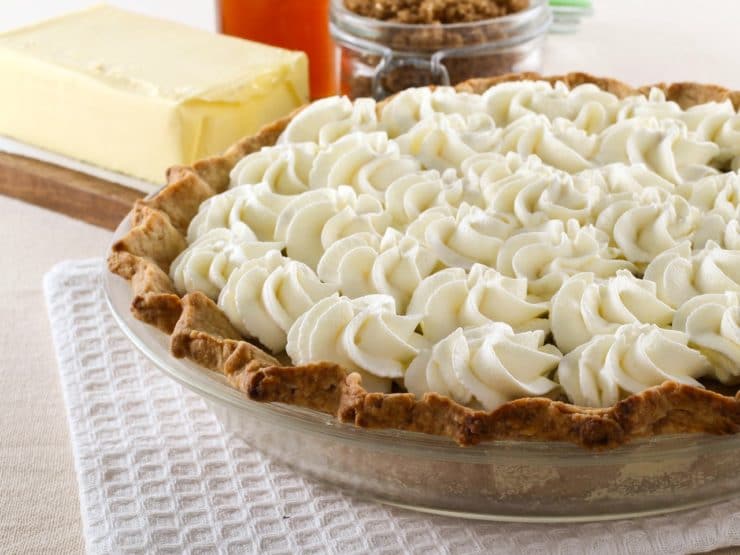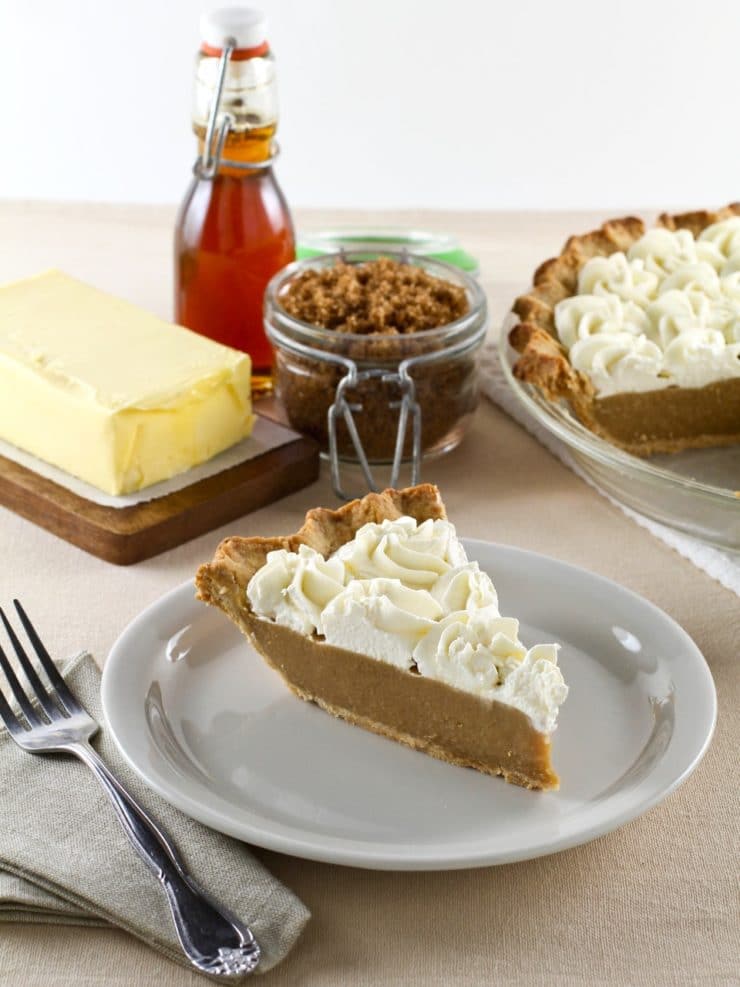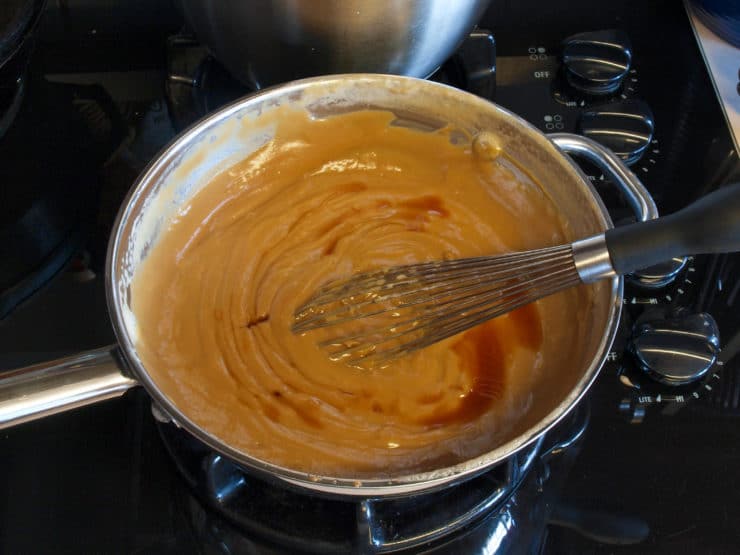This nostalgic butterscotch pie recipe is made with a lightly sweetened crust and filled with rich, buttery, caramelized butterscotch custard. It’s a vintage-inspired dessert that brings family memories to life!
Love homemade pies? Try my coconut cream pie, and learn more about the history of pie in America.
Thanks to my friend and fellow food blogger, Kelly Jaggers from Evil Shenanigans, for sharing the following story and recipe…
This recipe is inspired by the pies my father enjoyed growing up in 1940s San Antonio, Texas. With a buttery, brown sugar custard tucked inside a lightly sweet pie crust, it’s the kind of dessert that makes you want to slow down and savor each bite.
Whether you’re making it for Thanksgiving, a special gathering, or just because you love the cozy taste of caramelized brown sugar, this pie delivers rich, nostalgic flavor in every slice.
The Story Behind This Old-Fashioned Butterscotch Pie
My father is a natural storyteller. One of my favorite tales is about how he worked in a local bakery as a child, sweeping floors in exchange for sweet treats. One of his all-time favorite desserts was a creamy butterscotch pie made by the kind-hearted bakery owner. Even decades later, no butterscotch pie ever quite lived up to the one from that little San Antonio bakery.
So I set out to recreate it, testing, tweaking, and researching old cookbooks to find the perfect method. After a few tries, I landed on the version that brought that same childhood spark to my father’s eyes. He devoured it in a single day!
The Secret to the Best Butterscotch Pie
Through all my tests, I discovered that making a truly authentic butterscotch custard pie requires a few essential techniques:
- Brown the Butter and Caramelize the Sugar: This adds deep flavor that you can’t get by just mixing brown sugar into a custard base.
- Use a Blender or Food Processor: This helps create an ultra-smooth, silky texture and prevents curdling during tempering.
- Choose High-Quality Butter: This pie relies on the flavor of browned butter. So, it’s worth splurging for a better brand.

Recipe Ingredients and Notes
Please be sure to scroll down to the recipe card for the complete details!
- Pie Crust – You can use a pre-baked pie shell from the store, but I make a homemade pie crust from scratch using all-purpose flour, light brown sugar, salt, and butter. For a slightly more savory option, substitute a homemade all-butter pie crust instead.
- Light Brown Sugar – This sweetens the butterscotch filling, creating the rich, caramel-like taste we look for in butterscotch. If preferred, you can use dark brown sugar for an even more complex flavor.
- Unsalted Butter – This adds richness to the filling.
- Half and Half – I use this to thicken the pie filling, creating a rich flavor and silky consistency. I do not recommend substituting whole milk.
- Cornstarch – A thickener, this creates a more stable filling, preventing it from running all over the place once the pie is sliced.
- Egg Yolks – These create a rich, smooth filling and help bind the ingredients. Save the egg whites to make coconut pavlova!
- Vanilla Extract – I use this in both the filling and the topping to infuse the butterscotch pie with a delicious vanilla flavor. For the best results, look for high-quality pure vanilla extract, not imitation vanilla.
- Whipping Cream – Use this to create a sweet, fluffy, homemade whipped cream topping.
- Powdered Sugar – Also known as confectioner’s sugar, this sweetens the whipped cream without making it grainy.
How to Make a Homemade Butterscotch Pie Recipe
- Prepare the pie crust. Combine the dry ingredients in a bowl. Then, add the butter, and use your fingers or a pastry cutter to cut the butter into the mixture until it resembles coarse, pea-sized crumbs. Add cie water one tablespoon at a time until the mixture resembles a shaggy ball.
- Knead. Turn the pie dough onto a lightly floured surface, roll it into a disc, fold it in half, and flatten. Repeat three more times until the dough is smooth. Then, wrap it with plastic wrap, and chill in the fridge.
- Shape. Roll the room temperature dough into a 12-inch circle, and arrange it in a pie plate. Trim the crust, and crimp it with a fork or your fingers. Then, prick the bottom a few times to prevent air bubbles.
- Bake. Line the pie crust with parchment paper or aluminum foil, and fill the center with dry beans or pie weights. Transfer the pie to the oven, and bake just until light golden brown.
- Prepare the filling. Heat the brown sugar and butter in a medium saucepan on the stovetop. Bring the mixture to a boil over medium-high heat, and continue to cook until it smells like caramel. Then, remove from the heat.
- Blend. Pulse the wet filling ingredients in a food processor or blender. Then, with the blender running, slowly add the hot sugar and egg mixture.
- Thicken. Return the filling mixture to the saucepan, and cook over medium heat. Make sure to whisk constantly to thicken the mixture and prevent clumping. Turn off the heat, and stir in the vanilla.
- Cool. Pour the butterscotch pie filling into the prepared pie crust, and place plastic wrap on top. Set aside to cool. I recommend placing the pie on a wire rack to prevent the bottom from becoming soggy!
- Make the topping. When ready to serve, beat the heavy cream, powdered sugar, and vanilla in a stand mixer fitted with a whisk attachment (or using a hand mixer) until smooth, increasing the speed to medium-high until soft peaks form.
- Serve. Spread the meringue over the pie, and chill before cutting into slices. Enjoy!
Food Photography and Styling by Kelly Jaggers


Butterscotch Pie
Ingredients
Crust Ingredients
- 1 1/4 cups all-purpose flour
- 2 tablespoons light brown sugar, packed
- 1 teaspoon kosher salt
- 8 tablespoons unsalted butter, cubed and chilled
- 2-4 tablespoons ice water
Filling Ingredients
- 1 cup packed light brown sugar
- 4 tablespoons unsalted butter
- 2 cups half and half
- 1/4 cup cornstarch
- 3 egg yolks
- 2 teaspoons vanilla
Topping Ingredients
- 1 cup heavy whipping cream
- 3 tablespoons powdered sugar
- 1 teaspoon vanilla
Instructions
- Begin by preparing the crust. In a medium bowl combine the flour, brown sugar, and salt.

- Mix until well combined then add the cubed butter and, with your fingers, rub the butter into the flour mixture until the flour resembles coarse sand with pea sized pieces of butter remaining.

- Add the ice water a tablespoon at a time until the mixture forms a shaggy ball.

- Turn the dough out onto a lightly floured surface and press the dough into a rough disk. Fold the disk in half and flatten it out into a disk. Repeat this process three more times, or until the dough is smooth, then wrap the dough in plastic wrap and chill for at least one hour or up to three days.Heat the oven to 350°F. Remove the dough from the refrigerator and let it sit at room temperature for 10 minutes. Roll the dough out on a lightly floured work surface to a 12-inch circle that is about 1/8-inch thick. Turn the dough often, and dust the surface with additional flour as needed to prevent sticking.

- Carefully fold the crust in half and place it into a 9-inch pie pan. Unfold and press the crust into the pan. Do not pull or stretch the dough. Trim the crust so there is a ½-inch overhang around the edge of the pan. Fold the excess crust under and crimp the dough with a fork or your fingers. Gently prick the bottom of the crust a few times with a fork to help prevent large air bubbles from forming under the crust.

- Line the crust with parchment paper or aluminum foil and fill the crust with dry beans or pie weights.

- Bake the crust for 15 minutes, then carefully remove the lining and pie weights and return to the oven for 15 to 20 minutes more, or until the crust is golden brown all over. Allow the crust to cool completely to room temperature.

- Next, prepare the filling. In a medium saucepan add the brown sugar and butter.

- Heat the mixture over medium heat until the mixture comes to a boil. Cook for 30 seconds, or until the mixture starts to smell like caramel, then remove the mixture from the heat.In the work bowl of a food processor or blender add the half and half, cornstarch, and egg yolks. Blend for 30 seconds to combine then gradually, with the blender or food processor still running, begin adding the hot sugar mixture a tablespoon at a time until half the mixture is added. Stop the blender and add the remaining mixture and blend for 30 seconds or until the mixture is smooth.

- Return the mixture to the sauce pan and cook over medium heat, whisking constantly, until the mixture comes to a boil and thickens, about 8-10 minutes.

- Turn off the heat and whisk in the vanilla.

- Pour the mixture into the prepared crust and place a layer of plastic wrap directly on the filling. Cool for 30 minutes at room temperature, then refrigerate for at least 4 hours, or up to 2 days.

- When you are ready to serve prepare the whipped cream topping. In a large bowl with a hand mixer, or in the work bowl of a stand mixer fitted with the whip attachment, add the heavy cream, powdered sugar, and vanilla. Beat on low speed for 30 seconds to combine the powdered sugar, then increase the speed to medium-high and whip until the cream forms soft peaks, about 2-3 minutes.

- Pipe or spread the cream on the pie as desired. Chill for 30 minutes before serving.

NOTES
Nutrition

tried this recipe?
Let us know in the comments!
If you liked this recipe, I’d love it if you left me a star rating and comment below. Also, don’t forget to share and tag us on Facebook and Instagram!
FAQs
Yes! You have several options here:
1. Prepare the pie crust, and store the unbaked dough wrapped in plastic wrap in the fridge for up to 3 days.
2. Fill the crust with the butterscotch center, and store it covered in the refrigerator for up to 2 days.
3. Leave off the whipped topping, and store the baked pie covered in the refrigerator for up to 2 days.
Although similar, the two pies contain key differences in flavor. For example, butterscotch pie is made with brown sugar, which leads to a rich, molasses taste, associated with butterscotch flavor. Meanwhile, caramel pie is made with granulated sugar and cream, which creates a lighter, sweeter taste.
















hi. my family has a lot of allergies-one granddaughter allergic to whole eggs (yolk and whites). The other is only allergic to yolks. I use a lot of chia eggs in recipes. Is it possible to substitute the whites for the yolks in this recipe? As one of them is allergic to chocolate and loves butterscotch it would be a wonderful dessert for me to make. If I can’t use the yolks can I substitute the chia eggs (chia seeds and water) for the egg yolks? I make my own caramel all the time and never use eggs at all. what do the yolks add to this recipe?
I really would appreciate an answer for this. I am always looking for great recipes I can make they can all eat.
We have nut, egg, egg yolk, fish and sesame allergies in the family -I have to be very creative and have lots of fabulous options but really want to make this pie for them!